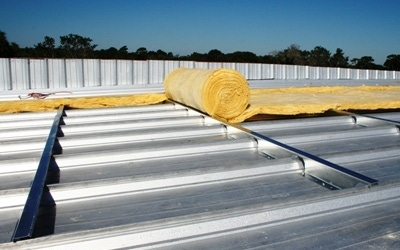If youre faced with replacing the old, metal roof on your self-storage facility, this article may save you time, trouble and money. Plus, it might show you how to get that new roof to pay for itself.
May 28, 2011

By Mark James
If youre faced with replacing the old, metal roof on your self-storage facility, this article may save you time, trouble and money. Plus, it might show you how to get that new roof to pay for itself.
When faced with having to install a new self-storage roof, most facility owners naturally think of roof replacementjust remove that old roof and install a new one in its place. Well, theres a simpler way of getting the job done.
Have you thought about retrofitting that old roof? Retrofit metal roofing has been touted for years as a viable and affordable alternative to roof replacement, one that will provide you with years of trouble-free service. Before we get into an explanation of this option, lets answer this question: If your old metal roof failed, why would you put another metal roof on your building?
Roofing technology has made great advancements over the past several decades. If your existing metal roof is 20 to 40 years old, it probably has an inferior coating or paint when compared to todays high-performance alternatives. It might have a galvanized substrate coating or paint system that chalked, faded and peeled within its service life of about 20 years.
Todays coatings and paint systems are under warranty for up to 35 years or more. In fact, the Galvalume coatings introduced about 30 years ago are showing no signs of degradation. In a recent scientific study, experts claimed these metal roofs could have a service life of 60-plus years.
How Its Done
Lets talk about retrofitting your roof with a new, structurally correct, high-performance metal roof. Very simply, were going to leave your old roof in place, leaving your tenants goods undisrupted, and install a new metal roof right on top of your old one. But to do this project the right way and achieve the real benefits, there are some things to consider.
Meeting building codes. New roofs are subject to the requirements of your local building codes. Your metal-roof manufacturer knows about these conditions and can design a roof to meet all wind- and gravity-load requirements.
Air space. When retrofitting, theres an air space created between the old and new roof that proposes the opportunity to install insulation for energy efficiency, and possibly turn one of your buildings into a climate-controlled structure. Regardless, adding insulation to your retrofit makes you eligible for a federal tax deduction of up to $1,500.
Also in this air space, a dynamic convective ventilation system can be employed. This system is called above-sheathing ventilation (ASV). Basically, it takes the heated air beneath the new metal roof and ventilates it through the ridge of the building. The benefit is the roof becomes a radiant barrier that reduces heat transfer through its assembly by as much as 45 percent. This system can be integrated with new insulation as well.
Cool roofs. Another fairly new advancement in the metal-roofing industry is what we call cool roofs. This is actually a paint system that has reflective properties and essentially resists the radiant heat of the sun. Its factory-applied to the metal and available in a multitude of colors. Case studies and research have indicated a reduction in heat transfer through the roof by an average of 17 percent, with a reduction in energy consumption by as much as 40 percent.
Solar panels. Depending on your location and local incentives, you may want to consider installing renewable solar photovoltaics (electricity) on your new metal roof. Most of the systems available have reduced in price in the past few years to the point where theyre much more affordable. Solar panels are capable of supplying you with all or most of the electricity needed to run your facility, and you might even be able to sell what you dont use back to the your electric supplier.
Now for the real benefits: There are major federal tax credits available through IRS Tax Code Section 179D for installing these systems on your existing building. The credits include a 30 percent dollar-for-dollar tax credit (not a deduction), plus accelerated depreciation of 50 percent in the first year and the balance over the following five years. On top of all of this, there may be state and local tax breaks, grants, funding and other incentives available.
Save Money
When you retrofit a new metal roof over any existing roof, youre adding additional weight to the building. Technically, this could be a concern to the structural integrity of the existing roofs support structure because it was certainly not designed to bear this additional weight. The good news is there are sub-framing systems available that have the ability to strengthen your existing roof system, thus compensating for the added weight of the new metal roof and sub-framing.
There are several ways of getting your new metal roof to pay for itself by employing todays integrated retrofit roofing technologies. Consider your options and ask the industrys leading roofing companies what they have to offer before your next roof-replacement project.
Mark James is vice president of sales and marketing for Roof Hugger Inc. Based in Odessa, Fla., the company is a provider of retrofit sub-purlins for existing metal roof profiles to allow re-roofing with new metal panels For more information, call 800.771.1711; visit www.roofhugger.com .
You May Also Like





